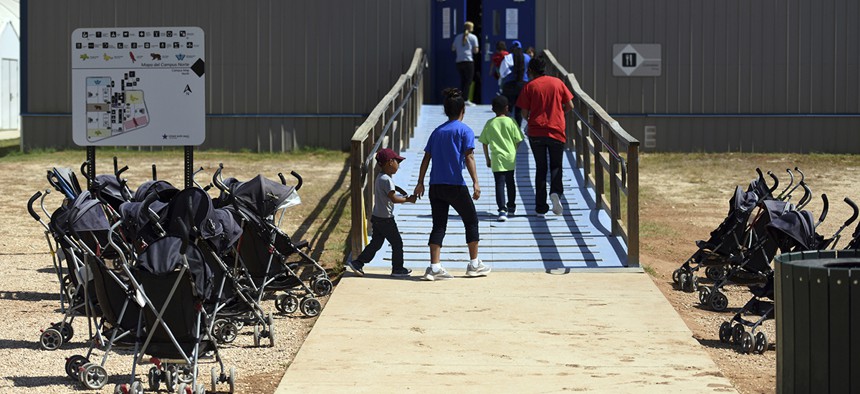IG: Incompatible Tech Added to Family Separation Policy Chaos

Immigrants walk into a building at South Texas Family Residential Center in Dilley, Texas. U.S. Immigration and Customs Enforcement/AP
The agencies tracking parents and children separated at the border had to email data and compile spreadsheets, an auditor found.
Incompatible IT systems and shoddy data sharing prevented agencies from reuniting children and parents separated at the border under the Trump administration’s stringent immigration policies, according to federal auditors.
The lack of integration between agencies’ immigration IT systems hampered efforts to identify and track children and families taken into federal custody while “increasing the risk that a child could become lost in the system,” the Homeland Security Department Inspector General said in a report released Tuesday.
Agencies’ haphazard coordination efforts, which relied partly on manually compiled spreadsheets, also kept Homeland Security from maintaining accurate data on separated families and “rais[ed] concerns about the accuracy of its reporting,” auditors said.
Under the administration’s “zero tolerance” policy, Customs and Border Protection split up families illegally crossing the border, sending adults to detention centers run by Immigration and Customs Enforcement and putting children in custody of the Health and Human Services Department. Because each agency manages immigration efforts using unique IT systems, they had a difficult time sharing information as family members moved through the immigration system, the IG found.
ICE officers told investigators the agency didn’t have access to family separation data maintained by CBP. As such, the agency couldn’t identify adult detainees who had been separated from children and make efforts to reunite the families.
Additionally, OIG found Homeland Security systems couldn’t fully connect to HHS’ IT infrastructure. When transferring unaccompanied minors, CBP officers would write up information on children in a Microsoft Word document and send it to HHS as an email attachment. CBP, ICE and HHS personnel manually compiled a spreadsheet with family members’ location information, but investigators found some of the information it contained was inaccurate and outdated.
Homeland Security officials in June announced they had created a database with HHS to share the whereabouts of parents and children, but auditors “found no evidence that such a database exists.” When asked to provide auditors with information that should’ve theoretically been accessible in the database—like the current location of separated children—they couldn’t immediately do so.
Homeland Security officials later told investigators there is no “direct electronic interface” between HHS tracking systems and their own, according to the report.
Homeland Security’s family separation database was also missing multiple children investigators themselves identified as having been separated at the border, which CBP attributed to agents submitting inaccurate information, the report said.
OIG found the database also contained inaccurate information on how far along parents were in the immigration process and whether children taken into HHS custody were with family or unaccompanied when they arrived at the border.
“OIG’s observations indicate that DHS was not fully prepared to implement the Zero Tolerance Policy, or to deal with certain effects of the policy following implementation,” investigators said.






